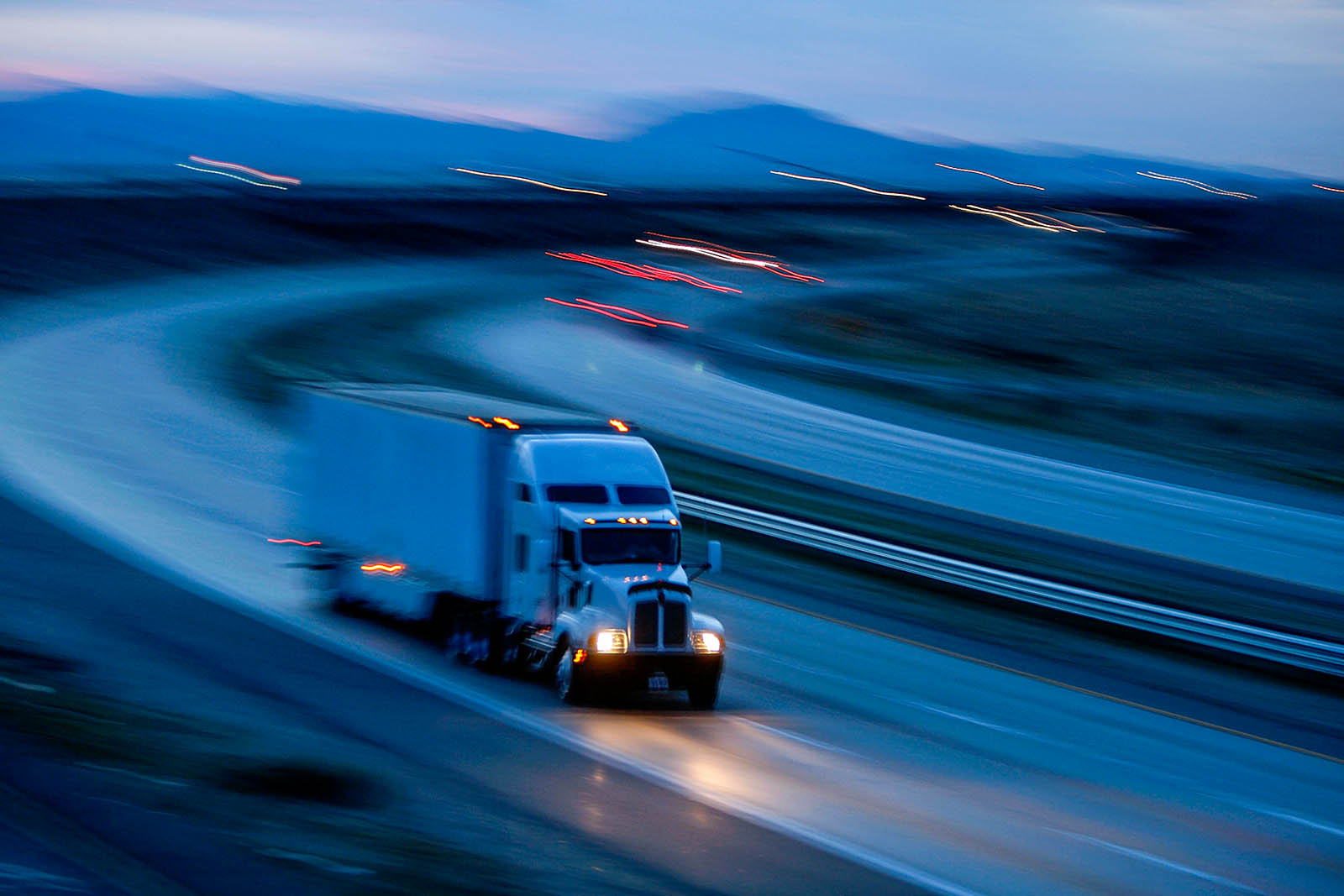The Surprising Beneficiaries of Autonomous Trucking

A truck travels the Interstate 10 freeway near Indio, California. Autonomous trucking may become more prevalent at a time of increased congestion, thereby benefitting shipping by rail.
Photo: David McNew/Getty Images
Congestion in U.S. cities is likely to grow in the near future due to a coming together of three factors: urbanization, increased ride sharing, and the arrival of autonomous cars and trucks. The likely beneficiary? Rail.
A recent Oliver Wyman report titled Autonomous Traffic Jam outlines these changes. As a result of several advances in technology—ranging from wirelessly connected trucks traveling together to a fleet of autonomous trucks led by a human driver—the report’s authors predict that the operating costs of trucking, for example, could drop as much as 40 percent within the next 15 years.
This is likely to lead to increased congestion, both in terms of time spent in traffic and in terms of how far congestion will spread outside of city centers, as well as the deterioration of highways and key infrastructure. This could lead to an increase in revenue for freight transport by rail.
The Trends Behind the Change
The report identifies two trends in particular that are likely to make urban areas more crowded—thereby increasing congestion and benefitting rail in the short term.
First, Americans are increasingly moving into cities and the suburbs surrounding metro areas. According to a Pew Research Center analysis of U.S. census data, “since 2000, more people left rural counties for urban, suburban or small metro counties than moved in from those areas.” In that time, the total share of Americans living in rural communities has shrunk from 16 percent to 14 percent.
Second, e-commerce is growing—therefore, we should expect more truck drivers out on the roads, delivering goods. Although e-commerce currently only accounts for 11.9 percent of retail sales, data points to the growing prominence of online shopping. According to the U.S. commerce department, brick-and-mortar retail is down 50 percent from 2000; non-store retail, on the other hand, is up 300 percent.
The Oliver Wyman report is blunt about the impacts of these two trends: “As the number of cars and trucks grows, roads are going to get a lot more crowded in the near term.”
The Rise of Ride-Sharing
These trends—coinciding with the advent of a number of private transit innovations—are likely to lead to increased congestion in urban centers.
In New York, for example, ride-hailing apps have led to an increase in ride demand: Between 2013 and 2017, the number of total passenger trips increased by 15 percent, even as the number of taxi trips declined. In that same time, for-hire vehicles traveled 36 percent more miles.
“That adds up to more than 600 million miles of motor vehicle traffic in the past three years alone—reflecting not only the staggering growth in rides, but also a trend toward lengthier trips and more ‘deadheading,’ or cars traveling without passengers,” writes CityLab’s Laura Bliss.
As ride-hailing apps siphon away riders and revenue from public transit options, it’s possible to envision a future in which demand for car rides—over subway or bus transit—increases even further. This is the environment in which autonomous trucks will likely begin their first trips en masse.
A huge increase in automobiles—especially trucks—on the road is likely to lead to serious wear and tear of roads and highways. “If you double the weight of a vehicle, the impact on the pavement is not double; it is exponentially higher than that,” Cesar Quiroga, a senior research engineer at the Texas A&M Transportation Institute, told Roads & Bridges. “A lot of people do not realize how critical this is.”
What Happens When Congestion Snares Trucks
“Given how integrated supply chains are, given how distributed people’s warehousing is, how much sourcing and manufacturing moves from one place to another where value is added, I’d have to say that urban congestion is going to affect pretty much everyone along the supply chain,” Allan Rutter, freight practice leader at the Texas A&M Transportation Institute, told BRINK news.
And congestion is only on track to get worse. Oliver Wyman’s report includes a series of maps of major metropolitan areas, comparing congestion data in 2016 to projections of how congestion will look in 2045. The change is striking: Where the 2016 maps display a mix of reds, oranges, yellows and greens showing relative congestion problem areas, the 2045 maps are almost entirely red.
Dallas Congestion Map, 2016
Cities are cognizant of these challenges—though they face significant challenges. “I think that [cities in Texas] see 2045, they know what’s coming,” Ginger Goodin, director of the Transportation Policy Research Center at the Texas A&M Transportation Institute, told BRINK News. “They’re trying to learn as much as they can learn as quickly as they can, so that as they understand how these new vehicles, these new systems, and these new data sources come online, they can begin to look at how they invest in infrastructure within the region to support that and how to avoid the red spiderweb map of 2045.”
Dallas Congestion Projections, 2045
State and local action on infrastructure is picking up the slack, but ultimately, a big part of the problem is how little regulators and policymakers functionally know about automation and its impacts. “I don’t think our policymakers have, rightly so, really grasped what this is going to look like in the long term, what is it going to look like in the interim, in the ugly transition between less automated vehicles and full automated vehicles,” says Ms. Goodin. “Until we have more demonstration and testing and we see pilots and we can measure performance and we can start to envision how that’s going to work, I don’t think that congestion strategies are specifically focused on how we prepare for automated vehicles. It’s just—how do we deal with congestion.”
A similar dynamic is playing out on the federal level. According to Mr. Rutter, federal automated vehicle legislation currently under consideration in Congress doesn’t address trucks at all. “It’ll be interesting to see how state and federal regulations respond to the expansion of automated trucks on the road,” says Mr. Rutter. “Some people think that because the motor carrier fleet is less numerous than the automobile fleet that automated trucks will be adopted faster. On the other hand, I think that people’s willingness to accept driverless trucks next to them on the interstate going 70 miles per hour—that’ll be an interesting process for elected officials and regulators to deal with.”
A Golden Age for Rail?
“One of the things that I’ve read recently is that if we ever get to autonomous trucking, then that will be the death of the rail industry. I totally disagree with that,” Nicholas Little, the director of Railway Education at Michigan State University’s Center for Railway Research & Education, told BRINK News.
According to Mr. Little, rail has built-in advantages that make it a strong player in a changing shipping ecosystem. Moreover, he expressed skepticism that autonomous trucking would reach mass implementation in the next 10 to 15 years.
“We might see some platooning in specific areas and at specific times of day, and I think that will give road a cost advantage. But rail is already there,” says Mr. Little. “We have trains. We have our own right of way. We are much more flexible in the way we can actually spend money on our infrastructure—because we own our infrastructure. We can actually invest in what is necessary to meet changes in demand.”
The Oliver Wyman report’s authors estimate that congestion—and the resulting diversion of shipping from trucks to rail—could lead to a 8.5 million additional rail shipments, an increase of 33 percent over contemporary projections. However, the report also cautions that “even if railroads are able to divert intermodal truck traffic for a time, their overall market share of transportation will still drop over the next 25 years; the only question is by how much.”
Mr. Little acknowledges this trend, saying, matter-of-factly, that the amount of coal and crude oil currently moved by rail is likely to decline substantially within the next 25 years. “What the railways will have to do, and I think they are positioned to be able to do this, is to fight back for smaller consignments that they used to be the sole—or at least the first—choice to move over any sort of distance over about 300 miles each way,” says Mr. Little. “To do that, they’ve got to really reinvent themselves. The most important thing is that they have got to make themselves part of their customers’ supply chains. They’ve really got to look at their business model, identify what their clear capabilities are, and who their customers are and what their customers need.”











